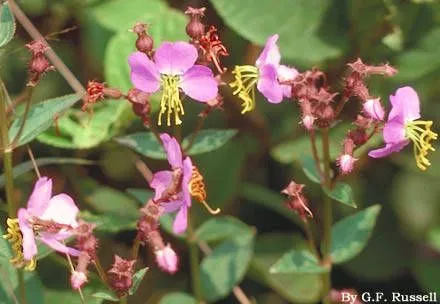
Author: L.
Bibliography: Sp. Pl.: 346 (1753)
Year: 1753
Status: accepted
Rank: species
Genus: Rhexia
Vegetable: False
Observations: E. Canada to C. & E. U.S.A.
Handsome Harry, scientifically known as Rhexia virginica, is a captivating member of the Melastomataceae family. This perennial herb boasts a widespread presence, flourishing in a range of ecological environments from Eastern Canada stretching down through Central and Eastern United States.
Characterized by its striking appearance, Handsome Harry features vibrant pink to purple flowers that command attention amidst the greenery. These blossoms are typically about an inch in diameter, exhibiting four distinct petals that surround a cluster of prominent yellow stamens. The stunning contrast between the petals and stamens not only enhances its aesthetic appeal but also serves to attract pollinators, primarily bees, ensuring the plant’s reproductive success.
The plant’s foliage is equally noteworthy. The leaves of Rhexia virginica are lance-shaped, with a hairy texture and serrated edges, contributing to its distinctive and slightly rugged look. They are arranged oppositely on the stem, providing a lush backdrop to the dazzling flowers. The stems themselves are often square in shape and may exhibit a reddish hue, particularly in the sunlight, further adding to the plant’s charm.
Handsome Harry thrives in wetland habitats, often found gracing the edges of ponds, marshes, and damp meadows. Its preference for moist, acidic soils makes it an excellent indicator of such environments. While tolerant to a degree of flooding, the plant does not fare well in excessively dry conditions, needing consistent moisture to maintain its vigor and vibrant appearance.
Ecologically, Rhexia virginica plays a vital role in its habitats. By attracting a variety of pollinators, it supports local biodiversity and contributes to the propagation of other flora within its ecosystem. Additionally, its presence can help stabilize soil in wetland areas, reducing erosion and promoting a healthy, balanced environment.
Historical documentation of Handsome Harry dates back to 1753, attributed to the renowned botanist Carolus Linnaeus, often cited by the abbreviation L. The plant’s enduring appeal and ecological significance have ensured its place in both botanical literature and natural landscapes across its native regions.
In summary, Rhexia virginica, or Handsome Harry, is celebrated not only for its visual allure and ecological contributions but also as an enduring subject of botanical interest. Its vibrant flowers and unique foliage, coupled with its role in supporting biodiversity, make it a cherished component of the flora throughout Eastern Canada and the Eastern United States.
Eng: common meadowbeauty, handsome harry, virginia meadow beauty, virginia meadowbeauty, common meadow beauty
Swe: skär ankarblomma
Fra: rhéxie de virginie, rhexie de virginie
En: Handsome Harry, Handsome-Harry, COMMON MEADOWBEAUTY, Virginia meadow beauty, Virginia meadowbeauty, Common meadow beauty
Fr: Rhéxie de Virginie, Rhexie de Virginie
Sv: Skär ankarblomma
: Handsome harry
Taken Aug 12, 2015 by EOL − brentano (cc-by-nc)
Taken Nov 21, 2014 by EOL − Matt Rung (cc-by-nc)
Taken Aug 16, 2022 by malot w (cc-by-sa)
Taken Oct 1, 2021 by Milo (cc-by-sa)
Taken Jan 10, 2021 by Stefani Bruno Andrade (cc-by-sa)
Taken May 14, 2021 by Kika56 (cc-by-sa)
Taken Jul 23, 2019 by RobinsNest (cc-by-sa)
Taken Jan 1, 1900 by EOL − John Hilty (cc-by-nc)
Taken Sep 2, 2015 by EOL − Matt Rung (cc-by-nc)
Taken Mar 4, 2021 by l e (cc-by-sa)
Taken Aug 22, 2020 by Megan Donaldson (cc-by-sa)
Taken Jan 1, 1900 by EOL − Smithsonian Institution, National Museum of Natural History, Department of Botany (cc-by-nc-sa)
Taken Aug 17, 2014 by EOL − randyhaar (cc-by-nc)
Taken Jul 25, 2014 by EOL − Jonathan Carpenter (cc-by-nc)
Taken Feb 14, 2015 by EOL − scottmohan (cc-by-nc)
Taken Aug 26, 2015 by EOL − Sam Kieschnick (cc-by-nc)
Growth habit>: Forb/herb
Family: Myrtaceae Author: (F.Muell.) K.D.Hill & L.A.S.Johnson Bibliography: Telopea 6: 402 (1995) Year: 1995 Status:…
Family: Rubiaceae Author: Pierre ex A.Froehner Bibliography: Notizbl. Bot. Gart. Berlin-Dahlem 1: 237 (1897) Year:…
Family: Sapindaceae Author: Koidz. Bibliography: J. Coll. Sci. Imp. Univ. Tokyo 32(1): 38 (1911) Year:…
Family: Asteraceae Author: A.Gray Bibliography: Pacif. Railr. Rep.: 107 (1857) Year: 1857 Status: accepted Rank:…
Family: Fabaceae Author: Medik. Bibliography: Vorles. Churpfälz. Phys.-Ökon. Ges. 2: 398 (1787) Year: 1787 Status:…
Family: Aspleniaceae Author: (Cav.) Alston Bibliography: Bull. Misc. Inform. Kew 1932: 309 (1932) Year: 1932…